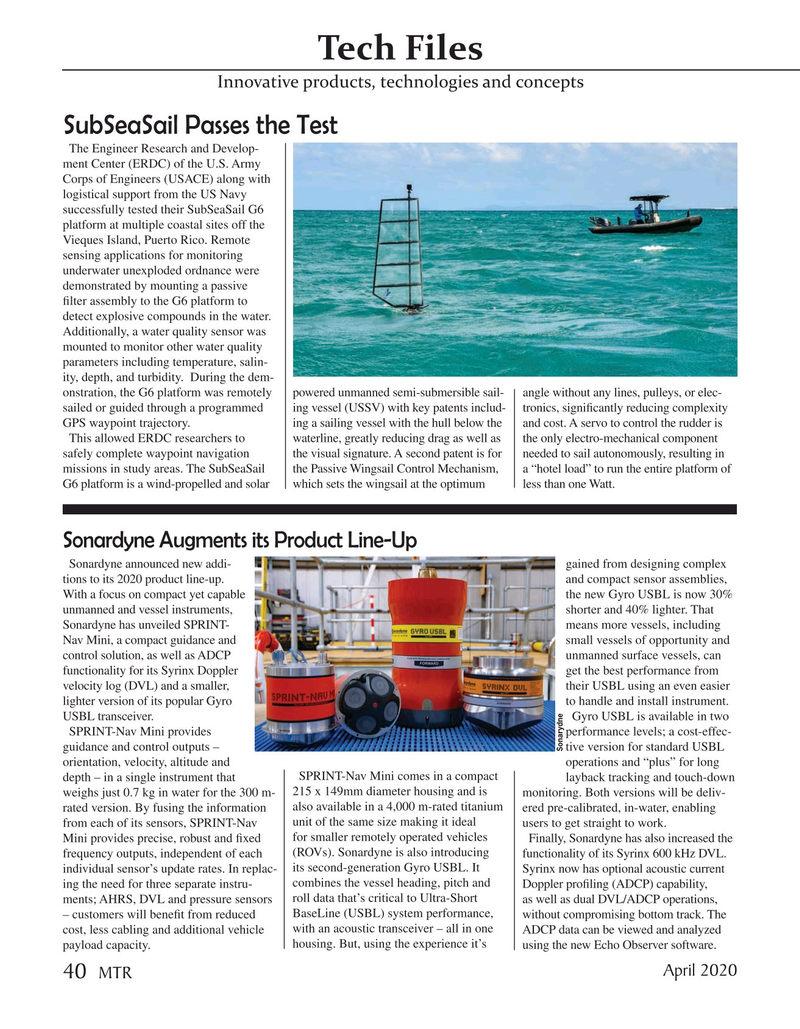
Page 40: of Marine Technology Magazine (April 2020)
Read this page in Pdf, Flash or Html5 edition of April 2020 Marine Technology Magazine
Tech Files
Innovative products, technologies and concepts
SubSeaSail Passes the Test
The Engineer Research and Develop- ment Center (ERDC) of the U.S. Army
Corps of Engineers (USACE) along with logistical support from the US Navy successfully tested their SubSeaSail G6 platform at multiple coastal sites off the
Vieques Island, Puerto Rico. Remote sensing applications for monitoring underwater unexploded ordnance were demonstrated by mounting a passive flter assembly to the G6 platform to detect explosive compounds in the water.
Additionally, a water quality sensor was mounted to monitor other water quality parameters including temperature, salin- ity, depth, and turbidity. During the dem- onstration, the G6 platform was remotely powered unmanned semi-submersible sail- angle without any lines, pulleys, or elec- sailed or guided through a programmed ing vessel (USSV) with key patents includ- tronics, signifcantly reducing complexity
GPS waypoint trajectory. ing a sailing vessel with the hull below the and cost. A servo to control the rudder is
This allowed ERDC researchers to waterline, greatly reducing drag as well as the only electro-mechanical component safely complete waypoint navigation the visual signature. A second patent is for needed to sail autonomously, resulting in missions in study areas. The SubSeaSail the Passive Wingsail Control Mechanism, a “hotel load” to run the entire platform of
G6 platform is a wind-propelled and solar which sets the wingsail at the optimum less than one Watt.
Sonardyne Augments its Product Line-Up
Sonardyne announced new addi- gained from designing complex tions to its 2020 product line-up. and compact sensor assemblies,
With a focus on compact yet capable the new Gyro USBL is now 30% unmanned and vessel instruments, shorter and 40% lighter. That
Sonardyne has unveiled SPRINT- means more vessels, including
Nav Mini, a compact guidance and small vessels of opportunity and control solution, as well as ADCP unmanned surface vessels, can functionality for its Syrinx Doppler get the best performance from velocity log (DVL) and a smaller, their USBL using an even easier lighter version of its popular Gyro to handle and install instrument.
USBL transceiver. Gyro USBL is available in two
SPRINT-Nav Mini provides performance levels; a cost-effec- guidance and control outputs – tive version for standard USBL
Sonarydne orientation, velocity, altitude and operations and “plus” for long depth – in a single instrument that SPRINT-Nav Mini comes in a compact layback tracking and touch-down weighs just 0.7 kg in water for the 300 m- 215 x 149mm diameter housing and is monitoring. Both versions will be deliv- rated version. By fusing the information also available in a 4,000 m-rated titanium ered pre-calibrated, in-water, enabling from each of its sensors, SPRINT-Nav unit of the same size making it ideal users to get straight to work.
Mini provides precise, robust and fxed for smaller remotely operated vehicles Finally, Sonardyne has also increased the frequency outputs, independent of each (ROVs). Sonardyne is also introducing functionality of its Syrinx 600 kHz DVL. individual sensor’s update rates. In replac- its second-generation Gyro USBL. It Syrinx now has optional acoustic current ing the need for three separate instru- combines the vessel heading, pitch and Doppler profling (ADCP) capability, ments; AHRS, DVL and pressure sensors roll data that’s critical to Ultra-Short as well as dual DVL/ADCP operations, – customers will beneft from reduced BaseLine (USBL) system performance, without compromising bottom track. The cost, less cabling and additional vehicle with an acoustic transceiver – all in one ADCP data can be viewed and analyzed payload capacity. housing. But, using the experience it’s using the new Echo Observer software.
April 2020 40
MTR

 39
39

 41
41
